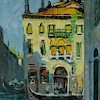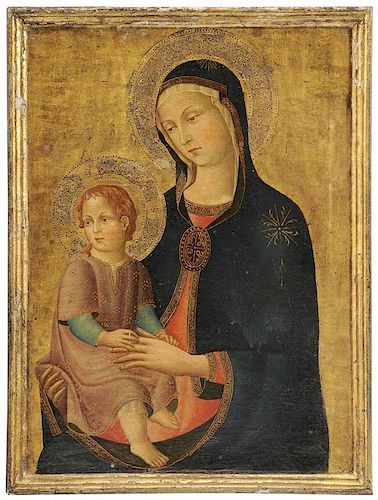Italian School
Bid Increments
| Price | Bid Increment |
|---|---|
| $0 | $25 |
| $100 | $50 |
| $1,000 | $100 |
| $2,000 | $200 |
| $3,000 | $250 |
| $5,000 | $500 |
| $10,000 | $1,000 |
| $20,000 | $2,000 |
| $50,000 | $5,000 |
| $100,000 | $10,000 |
(Siena, 14th/15th century or style) Madonna and Child, unsigned, tempera, gold leaf on linen over panel with punched decoration, 20-1/8 x 15-1/8 in.; engaged frame. Notes: This panel exhibits construction and materials consistent with Italian altar paintings of of the later Middle Ages. Jennifer Meagher, in her essay, Italian Painting of the Later Middle Ages states, "Through the fourteenth century, the primary support for portable paintings—from monumental church altarpieces to diminutive works used in private devotion, was the wooden panel. Masters were assisted by pupils and workshop members in their lengthy and complex preparation. Modern technical analysis and x-radiography have deepened our understanding of this process, allowing for a close examination of the materials and techniques used by the artist. The basis of our knowledge, however, is a 600-year-old source: a treatise on the art of painting called Il Libro dell’arte, composed about 1390 by the Italian painter Cennino Cennini (ca. 1370–ca. 1440). A seasoned plank—one that had been allowed to dry out for some time—was first layered with several coats of size, a glue made from animal skins. In Italy, the planks used for panel paintings were often made of native poplar, a widely available wood that was, however, soft and vulnerable to warping. A piece of linen soaked in size was often laid over the front of the panel to conceal any surface flaws. Over this, coats of gesso were applied. Gesso, a mixture of powdered calcium sulfate (commonly called gypsum) and animal glue, provided the ground for preliminary drawings. When the underdrawing was complete, the panel was ready for gilding. Areas to be gilded were prepared with a layer of bole, a reddish clay that provided an adhesive surface for fragile gold leaf. The gold leaf was made by pounding a small amount of gold into thin sheets, which were then applied to the panel using a tool called a gilder’s tip. The gilded surface was rubbed with a hard-tipped instrument to smooth and polish the gold leaf, a process known as burnishing. Additional decoration could be incised or stamped into the surface using metal rods, called punches, with patterns cut into one end. The tip of the punch, placed against the panel and struck from the other end with a mallet, pressed the design into the wood. Punching was often used to achieve the intricately detailed haloes surrounding the heads of holy figures. Finally, the panel could be painted. Medieval artists used tempera paints, made by mixing ground pigments with egg yolk. This medium produces a brilliant, pure hue. Many paintings of this period have engaged frame made of wooden strips attached to the outside edge of the panel, some examples of which survive." Meagher, Jennifer. "Italian Painting of the Later Middle Ages." In Heilbrunn Timeline of Art History. New York: The Metropolitan Museum of Art, 2000–. Http://www.metmuseum.org/toah/hd/iptg/hd_iptg.htm (September 2010). Provenance: Private Collection
Condition
craquelure, crackle, some flaking and other losses to gilding, some lifting from ground, verso of panel shaved
In house shipping. Brunk Auctions provides in-house shipping via UPS Ground (signature required) for many items. Brunk Auctions will provide a shipping quote which includes shipping, materials, labor and insurance. Insurance is based on the selling price and premium.
In order to provide an accurate shipping quote please provide the following:
- Shipping address
- Shipping method: if you have a UPS or Fed Ex account # we can bill your account 3rd Party and you can arrange payment for materials, labor and insurance. If you have your own insurance please send a signed waiver of liability.
Shipping arrangements are made only after the invoice is paid. The payment for shipping is a separate charge from payment of your lots.
Sales Tax: If you live in North Carolina and/or pick up from the auction house, and do not have a valid resale tax number on file with us, you MUST pay North Carolina state sales tax. The NC Sales Tax will not apply to any items being shipped out of state (unless the client resides in North Carolina) or to those clients with a resale tax number.









